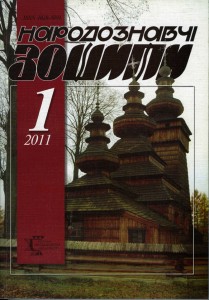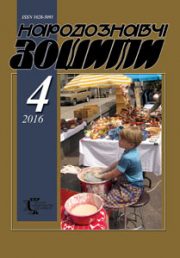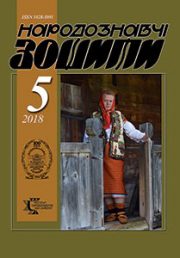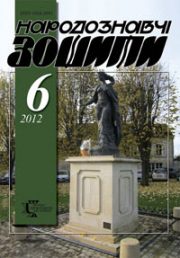
Content
Konovets S. On personal and spiritual development by means of fine arts. P. 3-13
In the article is considered a problem with realization of image of a mother by fine art creations viewed from the point of their influence upon various directions in humans’ personal and spiritual development. Image of a mother in particular has been presented in its mythological, sacral and artistic aspects via display of relevant creations by fine artistry (icons, paintings, sculptures). The contents of this article can be quite successfully used by students and lecturers of various educative institutions at preparation and carrying art classes as good as in facultative and additional studies.
Keyword: mother, image, art, creation, personal development
read »
Kis O. Feminist paradigm in socialand cultural anthropology: the western experience. P. 14-27
This article represents a comprehensive critical review of classical works in feminist anthropology; it reconstructs the origins and development of feminist methodology in social/cultural anthropology in Western Europe and the USA. The author consistently expounds and contrasts the ideas, views and arguments of the leading scholars; she also analyses the substance of academic discussions around the key issues of feminist analysis of culture (the origins and mechanisms of women’s subordination and marginalization), she traces the evolution of core concepts and theoretical approaches in feminist anthropology in the 1970—90s. This article helps to understand the origins of the contemporary gender studies in ethnographic research.
Keywords: feminist anthropology, patriarchy, androcentrism, matriarchy.
read »
Hlushko M. Who had record ed «narodny calendar u Rovenskim poviti Volynskoyi huberniyi»?. P. 28-42
On the basis of analytic studies in scientific heritage and creative course by Vasyl Domanytsky the author has proved, that the scholar had never visited Rivne County of Volhynia province and thus gathered no ethnographical and folklore materials there. His «Narodny calendar u Rovenskim poviti…» and other ethnographic works, concerned with traditional culture of inhabitants of the region, the scientist had prepared on the ground of ethnographic sources, gathered by Vasyl Abramovych — a clergyman of Yapoloti village, now Kostopil district, Rivne region.
Keywords: ethnology, folklore, traditional culture, Polissia of Ukraine, Vasyl Domanytsky, Vasyl Abramovych.
read »
Lunyo Y. Roman Shukhevych, the UPA commander-in-chief, in prosaic folklore of Yavoriv land. P. 43-65
In a wide massive of insurgent heroic epics, that had been registered by author along the Yavoriv land a group of motives connected with Roman Shukhevych — Commander-in-Chief of Ukrainian Insurgent Army — had been marked and put under an analytic study. The greater part of those creations came into being and was actively spread just in the time of reestablished Ukrainian statehood at 1991 because of new favorable conditions that arose then. Almost all registered in the mentioned area folk tales on Roman Shukhevych have originated out of poetic fiction — a point that proves quite significant socio-political, artistic and aesthetical importance of the person. The general himself is presented in the image of poeticized and glorified national hero, ideal fighter for independent Ukraine, a champion of wide circles of population.
Keywords: insurgent heroic epics, folk tales, national hero, R. Shukhevych, OUN, Ukrainian Insurgent Army.
read »
Movna U. Beekeeping as a phenomenon of ukrainian ritual culture in ethnographical publications of middle XIX to early XXI centuries. P. 66-77
The article deals with analyses of scientific achievements by native and foreign ethnographers from middle XIX to early XXI cc. in the sphere of studies as for ritual aspects of Ukrainian beekeeping. Scientific observations of the authors had been recorded mainly by means of occasional notes and thematic droppings into research background of publications on other problems and less in the form of relevant analytical research or thematic sections of individual monographs. The research has developed an array of valuable empirical source materials. The results of qualitative indicators of study in beekeeping as a phenomenon of Ukrainian ritual culture look much more modest.
Keywords: beekeeping, Ukrainian ritual culture, ethnographic studies, middle XIX to early XXI c.
read »
Romaniuk N. On traditional primal bathing and swaddle of a new-born baby in the territories of South-Western historio-ethnog raphical region. P. 78-86
This article presents study on a new-born baby’s first bathing and swaddle practisised by Ukrainians of the South-Western historio-ethnographical region. A series of acts connected with those rites are being successively described in the paper. Attention has been paid to close interconnections of rational and ritual characterisics of acts. The author has underlined quite important meaning given by surrounding persons exactly to the first bathing and swaddle. It is this stage of natal ritualism that furthered to realisation of parents’ general aspiration: to secure healthy development and fortunate fate for a baby.
Keywords: baby, first bathing, swaddle, Ukrainians, South-Western historio-ethnographical region.
read »
Syvak V. Eucharistic iconography in Ukrainian sacral paintings XVII—XVIII cent. P. 87-100
In the article an attention has been paid to formation of eucharistical iconography in the sacral art of Ukraine with tracing its origin and symbolic meaning. Characteristics have been given to symbolous allegorical compositions of XVII and XVIII cc. that demonstrate quite original Ukrainian variant of Eucharist theme spread in various kinds of sacral art.
Keywords: symbolization, Eucharist composition, sacral art.
read »
Skop P. On formation of traditions of mannerist art styling in the sacral painting of western Ukraine at the early XVII c. P. 101-107
The article deals with a set of problems as for stylistic transformations evident in the sacral art of Galicia at the early XVII c., i.e. period that had preceded to epoch of Baroque. On a basis of observational research-works in a group of artifacts of icon-painting the author has suggested his generalized conclusions concerning some characteristic tendencies in alteration of stylistic paradigm of painting manner. He also states that the presence of certain number of icons treating their plastic forms in a quite close way may be considered as manifestation of Lviv school of painting in a correspondent historical period. Special attention ISSN 1028-5091. Народознавчі зошити. № 1 (97), 2011 Становлення традицій мистецького стилю маньєризм в сакральному живописі поч. XVII ст. Західної України 107 has been paid to creations by F. Senkovych and M. Petrakhnovych- Morakhovsky. Possible analogies of key-works in thena- day painting have been mentioned.
Keywords: mannerism, artistic style, sacral painting, icon painting, transformation of image, portrait painting, iconographical scenes, mannerist elements.
read »
Bakovych O. On artistic and iconographical peculiarities of rococo styling in icon painting of Galicia at the second half XVIII c. P. 108-113
In the article are considered some main tendencies in development of icon painting of Galicia at the second half XVIII c. Special attention has been paid to features and certain artistic as well as iconographical peculiarities of those creations that make apparent nature of dominating then Rococo style. National specificity of Ukrainian icon artistry has been displayed as good as Western influences manifested by changes in building of composition, in range of colours, in treating of figures and distinct alteration at elaboration of image in creations of icon painting.
Keywords: Galicia, icon, icon painting, iconography, composition, colouring, rocaille, Rococo, style.
read »
Yanishevska N. Geometric styling as aim and method of form-creating in ukrainian and polish avant-garde: an analytic study in O. Bohomazov ’s and L. Chwistek’s theoretic and artistic heritage. P. 114-124
The article brings a research-work in theory and practice of Polish and Ukrainian Avant-Garde art with paying special attention to the modes of geometrical elaboration of forms that in 1910—1930 had been common to such trends of Polish and Ukrainian Avant-Garde as cubo-futurism, formalism, suprematism, constructivism. The study is focused upon creations of two artists: Olexandr Bogomazov and Leon Chwistek, brightest representatives of Ukrainian and Polish Avant-garde movements respectively.
Keywords: Avant-Garde, cubism, futurism, cubo-futurism, formalism, surrealism, form, geometric styling.
read »
Biyun Z. On «Hua Liao» painting in Chinese artistic culture of XX and early XXI cc. P. 125-128
Some problems in the present-day state of «flowers and birds» genre painting («hua liao») known as an old direction of traditional Chinese artistry is being considered in this article. Under thorough analysis have been put historically determined principles in build-up of genre compositions as well as main traditional modes in rendering of flower and bird motifs. Alterations in artistic and image structure have been traced since the middle XIX c. Attention has also been paid to influence by contemporary Western art upon specificity of traditional Chinese painting on the edge of XX and XXI cc. Numerous examples prove the present-day raising of the genre nowadays.
Keywords: «hua liao» («flowers and birds»), tradition, hierarchy in genres of painting, motif, mode of painting.
read »
Semkin V. Structural model of ad vertising process in a context of design activities. P. 129-133
The structural model of advertising process in a context of design activities that is possible to provide quality and efficiency of an advertising product with design and ergonomics methods are proved and developed.
Keywords: advertising, structural model, design, quality.
read »
Vynnychenko O.On fictile art of sculptural ceramics by Ulana Yaroshevych. P. 134-144
In the article has been considered an artistic and aesthetic phenomenon by known contemporary Lviv ceramist Ulana Yaroshevych’ creativeness. The artist’s formal search has been studied through the prism of traditional Ukrainian pottery that stimulated author’s fantasies in imaginative sphere of modern plastic art already. Special attention has been paid to artist’s ISSN 1028-5091. Народознавчі зошити. № 1 (97), 2011 Ольга ВИННИЧЕНК144 О technical and technological novelties. U. Yaroshevych’ rich creative experiences is differentiated after the signs of constructive spatial building and thematic diapason. With a view to scientific argumentation in problems of aesthetics the article has brought a formal analysis of most typical creations that present the essence of author’s conception and her mythologized world.
Keywords: artistic ceramics, contemporary art, decorative sculpture, pottery, form-creation, creative experiment, chamotte, anthropomorphic composition, national identity.
read »
Kost’-Hryhorchuk L. On Ukrainian ornate ligature letering. P. 145-154
In the article has been studied the Ukrainian ornate ligature lettering as a type of Cyrillic decorative writing spread in monuments of the written language by Ukrainians, Byelorussians and Romanians (Walachians, Moldavians). Some specific features in this kind of writing and its origin as well as directions of its development have been defined. Author’s special attention has been paid to a structure of lines in ornate ligatures, to conditions under which those were used and functional load of those in monuments of book-writing as good as in inscriptions in creations of Ukrainian sacral easel painting.
Keyword: sacral painting, icon painting, monuments of writing, paleography, ornate ligature lettering, system of decorative writing, Ukrainian type of ligature lettering, ligature.
read »
Movna M. City guidebooks of Lviv in interwar period (1919—1939): modern historical vision. P. 155-167
The article deals with first in Ukrainian Leopolitan studies attempt of research-work on history of guidebooks via our city of interwar period (1919—1939). The article defines typological belonging of city guides and accentuates on their subjects, ideological and linguistic varieties. Contribution by known authors, famous figures of epoch — М. Оrlowicz, B. Janusz, М. Holubec, І. Кripiakievich, М. Jarosiewicz, A. Меdynski and others have been revealed. General bibliography of guidebooks via our city of this period contains near 60 items.
Keywords: city guides, Lviv, history, interwar period, bibliography, modern historical vision.
read »
Shcherbyna K. «Troyisti muzyky» — treble musicians, their magical abilities and ties with unclean spirit (according to data of expedition in Bohorodchany region, Ivano-Frankivsk land, 2008). S. 168-170
The article is devoted to figures of «Troyisti Muzyky», the trio groups being central points of Ukrainians’ traditional folk musical life. Main attention here is to be paid to folklore notions as for musicians’ magical abilities and to correlation of their images with those of sorcerers. Aiming to better presentation of musicians’ magical acts we draw to the article some field ethnographical materials.
Keywords: «Troyisti Muzyky», folklore notions, musis, rite.
read »
Pelekh M. New-found monument of Lviv painting of the first third XVII to the early XVIII cc. from st.Nicholas the wonder-maker church in Yaktoriv, Lviv region. P. 171-178
Hereby for the first time is introduced — with the aim to be circulated in scientific research-works on art — an iconostasis, not completely saved until now, of the first third XVII c. from St. Nicholas the Wonder-Maker church in the village of Yaktoriv, Lviv Region. According to previous studies this iconostasis originates from a monastery Holy Erection church at Yasenytsia, Zolochiv district. In the early XX c. owing to metropolitan A. Sheptytsky’s efforts the iconostasis had been put to place at Yaktoriv. Due to its high artistic level of icon artistry the iconostasis may be considered as a creation of then-a-day Lviv professional school of painting, headed by Fedir Senkovych and Mykola Petrachnovych-Morokhovsky. Nevertheless the temple of St. Nicholas at Yaktoriv still has not been registered as Ukraine’s historical and cultural value.
Keywords: iconostasis, icon, iconography, Lviv centre of painting, ornamental carving, Mannerism ornament.
read »
Ludmyla Ivannykova. Weighty contribution into the history of Ukrainian folklore studies. P. 179-181
read »
Mykhailo Selivachov, Mykhailo Sahaydak, Petro Marusenko. On demarcation of art history. P. 182-183
read »








